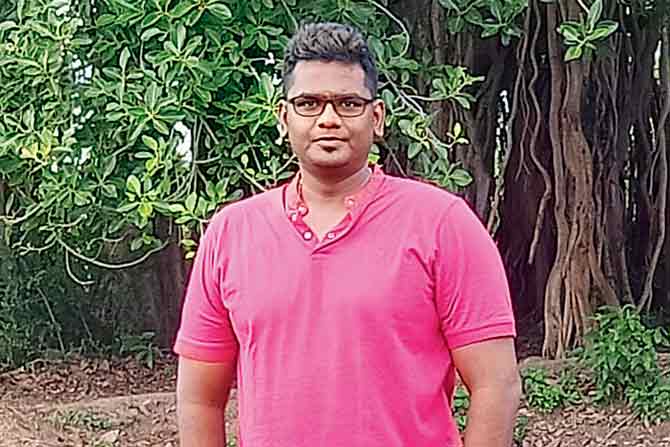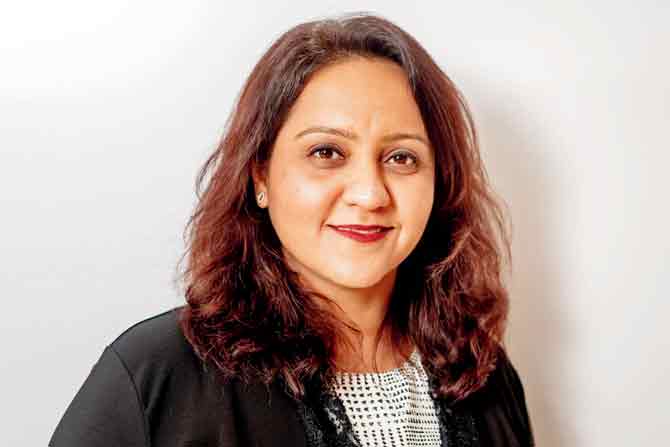
Siemon Kanagarayan, 37, is a Mumbai-based IT professional. He decided to fly to Tamil Nadu in March after his work trip to the UK got postponed indefinitely. He has been working out of Viluppuram for the past five months
Three months into the lockdown, 30-year-old Nikhil NK began experiencing sporadic bouts of anxiety. With the entire family of five—including wife Priyanka, sister Prajakta, and both parents—co-living in their Mulund home, Nikhil's diet had gone for a toss. "We cooked literally everything, without keeping a check on our consumption. While initially it felt nice to catch up on all the homecooked food that I had missed out on while working from office, it took a toll on my health. In May, I felt heaviness in the chest, and went for a check-up," recalls Nikhil. He was diagnosed with pre-hypertension. "The doctor suggested that I start exercising and lose some weight. But, there was a [COVID-19] positive case next door, so stepping out of the house for walks or runs was not an option. Working out indoors was not possible either; we all live in matchbox homes after all," he sighs.
ADVERTISEMENT

Nikhil NK and his wife Priyanka left for their Ahmednagar farmhouse in June, and have no immediate plans of returning to Mumbai
Just a week before the nationwide lockdown was imposed on March 24, Nikhil had seen the first slab of his dream farmhouse in Ahmednagar laid, over 250 km from Mumbai. The construction, however, was stalled due to the ban on all commercial, non-essential activity during the lockdown. "But, when the lockdown was partially lifted in June, I decided to put my life back into gear and drove to our holiday home. The house was still being built. We supervised the construction every day, coordinated with the contractor and workers and ensured the work got done, even if slowly. As we were already living at the site, we didn't want to rush it." It was an effort worth its while. "By the end of July, the size of my waist reduced from 40 to 34. And I credit life in the countryside for it," laughs Nikhil, who works at a pharmacovigilance firm in Thane.

He is among a gradually growing tribe of young professionals who have left Mumbai, for quieter places, despite full-time jobs.
Sion-based IT professional Siemon Kanagarayan is currently breathing in the fresh air of Viluppuram, a 20-minute drive from the coastal city of Puducherry. Designer and business owner Krati Valecha, who lives in Juhu, is taking in the scenic views of Aamby Valley City, a gated township in Pune.

Siemon Kanagarayan, IT professional; moved from Sion to Viluppuram in Tamil Nadu
Kanagarayan was working from home since March 10. On March 14, a day before he was scheduled to fly to the UK for a work trip, he got a call informing him that the trip was postponed indefinitely. The pandemic had caught the world by surprise, but the IT professional remained unfazed. "I had been following the news since January and gauging how countries such as China were reacting to the public health crisis. I knew that a lockdown was bound to happen in Mumbai." With his laptop in tow, the 37-year-old flew to Tamil Nadu.
With several companies beginning to permanently adopt work-from-home/anywhere models for select employees, professionals are choosing improved mental health in the countryside over city life.
When the Coronavirus spread was gaining a grip across American cities, New York quickly became the epicentre of the country's outbreak, spurring stay-at-home orders from officials to keep contagion at bay. New York Governor Andrew Cuomo did not mince his words when he described the reasons he saw for the rapid spread of the virus. "Why New York? Why are we seeing this level of infection? It's very simple. It's about density. It's about the number of people in a small geographic location allowing that virus to spread. Dense environments are its feeding grounds."
Ed Glaser, the author of Triumph of the City and an economics professor at Harvard University, told the New York Times that watching the Coronavirus devastate cities was like going back in time. "It feels it's back to smallpox, it's back to cholera," he said. "Cities were killing fields for centuries because of contagious disease," he added.
For centuries, cities have been plagued by periodic crisis. The Great Plague of 1665 killed 70,000 Londoners, and those who could afford to leave, fled the city. Comparing what's happening in American cities right now to events like the collapse of the investment banking company Lehman Brothers in 2008 or the 9/11 attacks, Jonathan Miller, a writer for a popular newsletter about New York real estate, to Fortune magazine, said, "There is an outbound migration. It's certainly happening." These events sparked a flight from New York, but not a permanent one. Many who left, returned in a couple of years. He expects that a similar phenomenon will occur with the pandemic, thanks to modern technology and the ability to work remotely.

Mohit Gundecha
Mohit Gundecha, CEO and founder, Jombay, a virtual assessment centre, says his was one of the first few companies in Mumbai to declare a "work from anywhere" policy till December 2020. "In these times, while you cannot offer certainty, you can definitely give clarity. And the sooner you offer clarity to your employees, the faster they can plan things out for themselves. Initially, a lot of companies were asking their staff to not leave the city, hoping things would normalise in a few weeks. But it is five months now, and the situation doesn't look like it's getting back to normal anytime soon. Even if a vaccine comes by December, it will take another 15 months for everyone to have accessed it. I don't see why employers should insist that their staff work from their Mumbai homes," Gundecha explains.
.jpg)
Mridul Khandelwal, director of a corporate advisories firm, also runs a steel company in Silvassa. He has been working from his Aamby Valley home for the past six months
Mridul Khandelwal, director of a corporate advisories firm Bondwell Group, agrees. When Maharashtra Chief Minister Uddhav Thackeray announced a curfew in mid-March and appealed employers to operate with 50 per cent workforce, Khandelwal thought of making a quick trip to his property in Aamby Valley City. "I thought I would relax during the weekend and then resume office on Monday. But, with the lockdown still in place, I have been stuck here with family, working from my home here for the last six months," says the 33-year-old businessman.

Mridul Khandelwal, director of corporate advisories firm; moved from Goregaon to Aamby Valley City
Khandelwal has no immediate plans of returning to his Goregaon home. But, the journey to get to this point wasn't easy. "Most of my staff includes seniors in the corporate industry; they are chartered accountants and MBA holders and fall in the age group of 40 to 60 years. Obviously, they are not tech-savvy. So, moving all our work online to cloud computing, getting the tech devices delivered to every staffer's home so that they could work remotely, and teaching them how to use the gadgets was definitely a task. But, three months since we started WFH, we are working at 85 per cent of our capacity. I am cracking deals with clients, and everyone is getting used to this new normal."

Krati Valecha, principal designer at Krava Design, is enjoying the scenic views at Aamby Valley. It’s the first time she has lived with her parents since she got married and says she is savouring her mum’s cooking and time with her dad
Valecha, principal designer at her interior design firm that specialises in residential projects, sees the challenges that arose out of working from home as a blessing in disguise. Hers is an "on site, in person" kind of job according to her, unlike a graphic designer or a lawyer, for whom computers are enough to get things done. How was she to know if the flooring is matching the wood, which in turn is matching the paint? However, working remotely meant that she had to adapt to virtual solutions. Instead of creating mood boards and personally showing it to her clients, she creates photorealistic renders now and gets on a Zoom call with them. "Honestly, the Coronavirus lockdown has pushed us in the right direction. We have become smarter and I wonder why we weren't doing this all along?"
Khandelwal also owns a steel company in Silvassa, which he would regularly visit to supervise on-site workers. But, being stuck in Aamby Valley meant he could no longer visit his team. "When you are the boss, you have a tendency to micro-manage. Since I had no option, I had to supervise my team on the phone. And it is incredible how we are working at 90 per cent of our capacity."

Rujuta Date
"The way our cities are planned means that there is a business centre like BKC or CST and then there are residential zones. Work moving online takes this geographical centre away," says Rujuta Date, an anthropologist. She adds that there is no need to be close to a centre of commerce anymore. Employment service LinkedIn saw the volume of job searches using the "remote" filter increase by 60 per cent since March. They observed a strong growth in remote job applications across key markets, such as China, New Zealand, Australia, and Singapore, with India leading the pack. "While the demand for remote roles from talent outstrips the growth in remote jobs on offer, it is clear that organisations are adapting to a more dispersed workforce. We are seeing geographic barriers breaking down, and early trends show that organisations in India are open to hiring a remote workforce based in different cities," says Ruchee Anand, director of talent and learning solutions at LinkedIn, India.
However, industry observers also point out to the danger of assuming all businesses are amenable to hundred per cent WFH.
Sunder Ramachandran, general manager, training, GSK Pharmaceuticals India, a research-based pharmaceuticals and healthcare company, is one of them. He believes not all industries lend themselves to an indefinite work-from-home or work from anywhere policy. "The most common example is a distribution company, where the job places a demand to be physically present at work. A retail firm may require you to go to work at least once a week. If you are a warehouse manager/supervisor or a supply chain manager for one of the warehouses of Amazon or Flipkart or another retail and manufacturing firm, your job would involve making multiple trips to warehouse units located in Bhiwandi, for example. The other obvious example would be customer-facing work environments such as telecom providers. There, you need staff at the front end," he says. He also points out that real estate in Mumbai is a challenge, and thus, everyone here has small homes. "Not everyone can afford the luxury of a property in the outskirts, from where they can work remotely. Sometimes in a long-term WFH scenario, handling both household and office work gets tough. So, a lot of progressive companies in fact, find a balance. They allow their employees to come to work once or twice week. In addition to fulfilling requirements that certain role executions and product/service creation may demand, it also keeps the employees in good spirits. It helps them connect with themselves and other team members, while also allowing them time to get away from the household for a bit. Many organisations have realised this and are thus not issuing blanket work-from-home-indefinitely orders."
Being a software test engineer meant that Kanagarayan had to sit in front of a computer for long hours every day, staring at a screen. "I was telling my mother how I desperately needed a long break. Four to five months of relaxing. My work can get monotonous and I had almost started feeling like a machine," he says. His company's decision to allow its employees to work from home till the end of August, has meant that this is the longest he has ever been away from Mumbai. It looks like the simple life is growing on him because he plans to continue living there unless his company insists he return. "I step out for a brisk walk every morning and am amazed by the clean air. I don't miss Mumbai's water logging or pollution. Here, you have access to fresh, farm foods. It's organic and healthy," he says.
There are some hitches, of course. Poor Internet connectivity is the chief obstacle, when work must continue and deadlines need to be met. WiFi dongles have come to the rescue. But, a few glitches seem to be nothing compared to the benefits.

Ruchee Anand
Valecha says it's hard to miss the city when she has the option of going for walks by the lake and relishing her mother's cooking. "It's inspiring to look at the views here, and work. It has positively impacted my creativity. It's hard to think of going back to living in a 10x10 room. I don't want to be cooped up in my little apartment anymore."
Nikhil's routine now includes waking up at 9 am, exercising, helping his wife with gardening, coordinating with the construction workers, followed by a siesta and then taking on office work which goes on late into the night. "It's perfect. This escape has been a blessing."
That Mumbai turned out to be a Coronavirus hotspot and continues to be one, means return journeys are not being planned yet. "We came to Aamby Valley for a month and got used to the serenity. It takes 21 days to make or break a habit, right? Obviously, we like that it's not a hotspot and don't see the need to return soon," says Valecha.
According to Date, it's a choice between access to quality healthcare, which is available in a city versus accepting that even though you are moving further away from it, the chances of you contracting the infection are lower. "The ones who are moving are doing so with the knowledge that they think it's safer. No matter where you live in Mumbai, you can't escape crowding. A sense of panic was setting in as the cases were coming closer."
But what Kanagarayan does miss is Mumbai's hustle. "There is an energy which I can't describe. It's the spirit of the city that keeps it going no matter what obstacle might come its way."
Catch up on all the latest Mumbai news, crime news, current affairs, and a complete guide from food to things to do and events across Mumbai. Also download the new mid-day Android and iOS apps to get latest updates.
Mid-Day is now on Telegram. Click here to join our channel (@middayinfomedialtd) and stay updated with the latest news
 Subscribe today by clicking the link and stay updated with the latest news!" Click here!
Subscribe today by clicking the link and stay updated with the latest news!" Click here!






